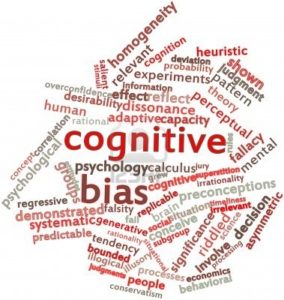 Recently I’ve come across some decisions that I couldn’t understand. This got me thinking about how our brains are wired for ‘easy’ solutions. But that these solutions may not be the best answer but the biased answer.
Recently I’ve come across some decisions that I couldn’t understand. This got me thinking about how our brains are wired for ‘easy’ solutions. But that these solutions may not be the best answer but the biased answer.
Examples of bias
Have you experienced decisions such as:
- Someone appointed to lead a project, because they have done a good job elsewhere. The project demands technical knowledge that this person does not have. But the decision-maker thinks that success in one area means s/he will be successful anywhere. This is an example of the ‘Halo effect’.
- As soon as the candidate walked into the room, you could see that they wouldn’t be ‘right’. Maybe it was their appearance, which was nothing like your own expectation of what a suitable employee looks like. Those expectations are examples of ‘Anchors’ bias.
- You’re at a brainstorming session and one person is particularly vocal, pushing their idea and cutting short others. They advocate their idea so much and with such optimism that it is adopted by the group. This is an example of the ‘Affect’ bias and if this person benefits by the adoption of their idea, it’s also an example of ‘Self-interest’.
- Do people over-weight current experience and data, making the other option(s) look too risky? This may be an example of Status Quo bias – “better the devil you know…”
- The project review identifies that the likelihood of the project delivering the planned benefits is low and it needs significant further investment to get back on track. Yet the discussion focuses on how “we’ve got this far, we should keep going and make a success of it”. This is an example of ‘Sunk cost’ bias.
- Even though the organisation wants a focus on innovation, you find that senior decision-makers favour development of current products over truly innovative ideas. People prefer information that relates to their existing experience and discount contradictory data. This is an example of Confirmation bias, where we prefer to work with what we know, confirming our existing sense of self.
- A recent success in one product results in senior management prioritising similar developments, without fully assessing whether there is adequate demand for more offers in this space. This is an example of Saliency bias.
So what can you do about it?
The first step is to be aware of these typical biases. This is not an exclusive list, there are many other similar patterns playing out both in the workplace and in life.
Then to hold this awareness at the forefront of your consciousness so that you raise the questions to check the information used and the decision-making process for potential bias.
You can also put in place planning and decision-making processes that safeguard against bias. Such as:
- Multiple data sources
- Diverse opinions and perspectives
- Include downside risk assessment
- Consider potential negative outcomes for company, industry, and broader ecosystem.
Conclusion
The key to avoiding poor decisions due to bias in your thinking, is to remain aware of potential bias and always ask yourself questions to challenge any biased thinking.
Please do share your stories of bias and add your comments here.

